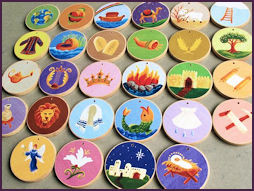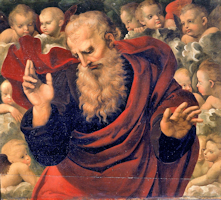Advent: December 2nd
First Sunday of Advent
» Enjoy our Liturgical Seasons series of e-books!
Old Calendar: First Sunday of Advent
For Catholics, the new Liturgical Year commences with the first Sunday of Advent. In this new liturgical year, the Church not only wishes to indicate the beginning of a period, but the beginning of a renewed commitment to the faith by all those who follow Christ, the Lord. This time of prayer and path of penance that is so powerful, rich and intense, endeavors to give us a renewed impetus to truly welcome the message of the One who was incarnated for us. In fact, the entire Liturgy of the Advent season, will spur us to an awakening in our Christian life and will put us in a ‘vigilant’ disposition, to wait for Our Lord Jesus who is coming:
‘Awaken! Remember that God comes! Not yesterday, not tomorrow, but today, now! The one true God, "the God of Abraham, Isaac and Jacob", is not a God who is there in Heaven, unconcerned with us and our history, but he is the-God-who-comes.’1
The Season of Advent is therefore a season of vigilant waiting, that prepares us to welcome the mystery of the Word Incarnate, who will give the ‘Light’ to the womb of the Virgin Mary, but essentially this time prepares us not only to welcome this great event but to incarnate it in our lives. We could say that the true light enters the world through the immaculate womb of Mary but it does not stay there. On the contrary, this light flows out into our dark, obscure, sinful lives to illuminate them, so that we can become the light that illuminates the world. For this reason, let us live this time of waiting not only to celebrate a historical memory but to repeat this memory in our lives and in the service of others. To wait for the Lord who comes, means to wait and to watch so that the Word of Love enters inside us and focuses us every day of our lives.
As Blessed John Henry Newman reminded us in a homily for the Advent Season: “Advent is a time of waiting, it is a time of joy because the coming of Christ is not only a gift of grace and salvation but it is also a time of commitment because it motivates us to live the present as a time of responsibility and vigilance. This ‘vigilance’ means the necessity, the urgency of an industrious, living ‘wait’. To make all this happen, then we need to wake up, as we are warned by the apostle to the Gentiles, in today's reading to the Romans: ‘Besides this you know what hour it is, how it is full time now for you to wake from sleep. For salvation is nearer to us now than when we first believed” (Rm 13:11).
We must start our journey to ascend to the mountain of the Lord, to be illuminated by His Words of peace and to allow Him to indicate the path to tread (cf. Is 2:1-5). Moreover, we must change our conduct abandoning the works of darkness and put on the ‘armor of light’ and so seek only to do God’s work and to abandon the deeds of the flesh (cf. Rm 13:12-14). Jesus, through the story in the parable, outlines the Christian life style that must not be distracted and indifferent but must be vigilant and recognize even the smallest sign of the Lord’s coming because we don’t know the hour in which He will arrive (cf. Mt 24:39-44)
1 Pope Benedict XVI, Celebration of First Vespers of Advent, Vatican Basilica, December 2006
Excerpted from the website of Congregation for the Clergy
![]()
The traditional Collect (or opening prayer) of the last Sunday of the Church year began "Stir up the wills of Thy faithful people, we beseech Thee, O Lord..." With this request to God to "stir up" our wills, this day was traditionally called Stir-Up Sunday. Because the Ordinary Form celebrates the Solemnity of Christ the King on the last Sunday of the year, "Stir-Up Sunday" is often the First Sunday of Advent. The traditional Collect of the First Sunday is asking God to stir up His might: "Stir up Thy might, we beg Thee, and come." Many families create a traditional plum pudding or fruit cake or some other recipe that all the family and guests can "stir-up." This activity of stirring-up the ingredients symbolizes our hearts that must be stirred in preparation for Christ's birth.
What You Need to Know About Advent
A short explanation of the Advent season and its significance in the Liturgical Year.
The History, Customs and Folklore of Advent
Resources for Celebrating Advent in the Home
 Jesse Tree Overview
Jesse Tree Overview
The Jesse Tree dates back to the middle ages and came from Europe. Even some ancient cathedrals have Jesse Tree designs in their stained glass windows. The "tree" is usually a branch or sapling and is decorated with various symbols that remind us of the purpose and promises of God from Creation to the Birth of Jesus Christ.
Jesse was the father of King David and God promised David that his Kingdom would last forever. Two centuries after the death of King David, God spoke through the prophet Isaiah and said:
And there shall come forth a rod out of the stem of Jesse, and a branch shall grow out of his roots: and the spirit of the Lord shall rest upon him: the spirit of wisdom and understanding, the spirit of counsel and fortitude, the spirit of knowledge, and of the fear of the Lord. (Isaiah 11:1-2)
Each Jesse Tree ornament usually consists of a handmade symbol or drawing that represents one of the major stories of the Old Testament along with a brief verse of Scripture from that story.
